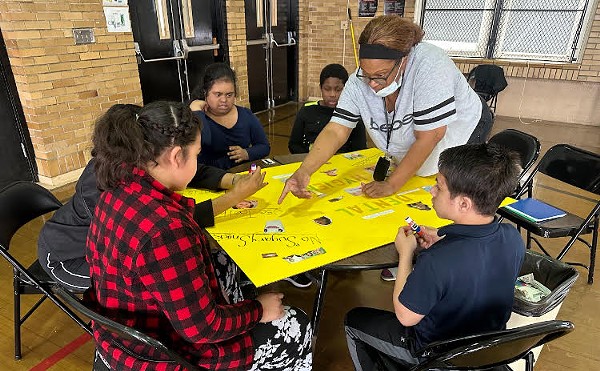If I had seen him anywhere else, I would have called him my next-door neighbor. I would have told you he was the nicest one in that building, actually. We always exchanged pleasantries whenever we crossed paths, which was pretty often, because during the summer and fall, he always seemed to be sitting in a lawn chair with a few other guys around a barbecue. I had always assumed he lived there.
I was wrong.
When I first see him, we are packed like sardines in a crowded hallway at St. Vincent de Paul’s Ozanam Inn, the men’s homeless shelter on Jackson Street, between St. Catherine and Kentucky streets. It’s just after 4 in the afternoon, so the sun hasn’t even set yet on this mid-February day, but the temperature is already below freezing. This means it qualifies as a “white flag” night. Nobody will be turned away from the shelter, even when beds are all full — and the beds here are always full.
Checking in for the night involves passing a Breathalyzer test and showing some form of identification. Also, if men have any medication, they are expected to relinquish it here, where it’ll be under lock and key and dispensed individually when needed. On a normal day, check-in ends with a man being given a towel and told to shower in order to ensure community comfort and health while in these close quarters. Today, though, there is some LG&E issue and only cold water is coming through, so the rule is relaxed.
“I didn’t know you work for LEO,” my not-next-door neighbor says to me when we talk in the kitchen during the 5 p.m. open dinner service. The only reaction I can muster is an awkward chuckle. After all, my ignorance about his life seems far more egregious than his.
A few minutes later, St. Vincent program director Cory Bledsoe will tell me the biggest misconception about people in homeless shelters is the idea that they are that different from you and me. “People don’t realize that the person serving them your coffee in the morning could be homeless,” he says.
No kidding, I think to myself.
I find out his name is Robert Morales. Some people wouldn’t consider him homeless. Tonight is his first night here at St. Vincent’s, at least in a while. He had been living in an apartment with a roommate, but the roommate wasn’t very stable and it turned into a toxic environment.
“I’m in the process of finding a new permanent place to live,” Morales tells me. “This place is just my lifeline.”
It is a lifeline he has used in the past, like during those four years when he fought to get approved for Supplemental Security Income (SSI). A former construction worker, Morales’ life changed forever when his foot got caught on a loose nail at a job site and he tumbled down a spiral staircase. As a result, he wound up with a steel plate with seven screws in his ankle. It made him instantly a liability among the employers who once would have hired him.
“It’s amazing how quickly life can change,” Morales contemplates aloud. He says it as a matter of fact, not a bemoaning of his current situation. “I’d like to go back to work, but this is what life drew for me.”
The homeless are often reduced to people spoken about rather than to. This is especially true during a winter that will forever be synonymous with the phrase “polar vortex.” Shelters have been pushed to their limits by a higher-than-average number of white-flag nights. When I visited St. Vincent’s on Feb. 12, the number of white-flag days for February had already more than doubled last year’s numbers for the same month. In January 2014, 29 of the 31 days were white flag.
All this strain depleted the allocated white-flag funding. In response to media attention about the shortage, the community stepped up with physical donations and financial assistance. LG&E and Kentucky Utilities Company donated nearly $50,000 to a dozen shelters and day centers to help ease the financial burden. Yet not much had been heard about the people heeding the warning of the white flag.
St. Vincent typically sees an extra 40 to 50 people on a white-flag night. One night, when one of the other shelters couldn’t accommodate people, it almost burst at the seams with 80 additional people. They sleep on air mattresses lined up in the kitchen and rec room. There’s no privacy, no level of comfort beyond not freezing to death — which, in the hierarchy of needs, I guess isn’t too bad a deal.
There is no typical story of the homeless. Each man, woman and child who comes through Louisville’s three emergency shelters — St. Vincent de Paul, Wayside Christian Mission and the Salvation Army’s Center of Hope — has a unique story. The value in sampling some of them is in the broad strokes painted, the common threads that flow through their stories of circumstances and bad decisions, of loss and love.
“It’s been rough,” says one woman currently living at the women’s shelter at Wayside Christian Mission. “This wasn’t a place I wanted to come, but I had no choice.”
The 30-year-old, who asked that her name be withheld, lives paycheck to paycheck, so when she was laid off in January, she couldn’t afford to pay rent and lost her apartment. After about a month of the shelter life, she says her patience is stretched thin, and her temper on edge.
“I think I need to go to Seven Counties, because my anger is bad now,” she says, referring to the mental health center that serves the homeless population. “There are some (staff here) who want to help. Then there are some that talk to you like you’re not human.”
Wayside policy states she can’t leave the campus after 4:30 p.m., which can make it difficult to get things done. St. Vincent’s has a similar policy. The rule is designed to keep people sober and safe while inside the shelter, and exceptions can be made to people for verifiable reasons like a job or Alcoholics Anonymous meetings. Still, the restriction can make someone feel more like a caged hamster than a person.
White-flag nights are particularly rough, she says, because they bring out more of the chronically homeless and people with mental health or chemical dependency issues. Though the homeless deal with mental health and dependency issues at a greater percentage than the general public, the majority of homeless aren’t addicts or insane.
“Most of us just need a decent job,” she says.
Luckily for her, she sees a light at the end of this tunnel. She’s got a job offer for a health care company. She’s just waiting on the background check to come through. Once it does, she’ll move back into her own place, where nobody watches her every move. She’ll do what she can to save for a one-way trip back to Alabama, where her ill mother and the rest of her family live.
“Two weeks and I’m out (of the shelter). In May, I’m leaving the city for good,” she says. “I’m done with Louisville. I just want to squeeze my mama until she can’t take it. The parade is already getting started for me back home.”
Wayside Christian Mission’s chief operations officer Nina Moseley knows shelter life can be a rough transition and that some people want to be left as alone as possible, but she says the interaction between staff and visitor is calculated and key to operations, especially within the emergency shelter community.
“Our goal is always to get people into a program,” she explains. That means telling everyone who comes through their doors about the services they offer and giving them repeated opportunities to commit to using them. “Everyone who went through one of our programs came through the emergency shelter.”
I guess if there’s any upside to being an overcrowded emergency shelter constantly on the verge of running out of basic household items like soap and toilet paper, this is it. White flag allows case managers and other professionals to interact with people they might not normally reach. That exposure, says Moseley, could lead to one of them taking the next step and getting help.
Bledsoe agrees.
“I think some view emergency shelters as just them hanging out all day and night. It’s not true. It’s not just about a bed. On a base level, we are trying to engage people and trying to get them to end their homelessness,” he says. “Our soup kitchen is the biggest outreach. People come, they sit next to someone staying here, and they hear about what we can do for them.”
Steven Kelly was enrolled from day one in St. Vincent’s newest recovery-focused emergency shelter program, a rigorous treatment designed for homeless people struggling with chemical dependency issues. Enrollment is limited to 18 — that’s the number of beds in the cramped dorm-style room that houses everyone in the program.
Their day begins at 9 a.m. with morning meditation, where they ask themselves what they will be bringing to the world today. Then, they start psycho-educational lessons to teach them about addiction and mental health. They’ll detour from that into an Alcoholics Anonymous program. After that is lunch at the soup kitchen, followed by more classes. Free time, which also includes volunteering at the soup kitchen or cleaning the dorms, runs from 2 to 6 p.m. Once that stretch ends, there’s another class, usually involving some sort of guest speaker. There’s another group meeting at 8 p.m. Nightly meditation starts at 9 p.m., where they ask themselves if they achieved all they set out to do that morning. Lights out is at 11 p.m.
The demanding schedule leaves little alone time or opportunities for relapse. Kelly, who has gone through substance abuse programs before, knows this is a good thing. He is more confident than ever that this one will stick.
He’s stuck with it since Oct. 29, anyway. That’s a feat not all of his fellow inaugural enrollees can say.
“I’ve been willing before,” he says when I ask him why he thinks this time will be different. “This program is just more supportive. I got 17 guys keeping me accountable.”
Kelly would like to get back to that place where he was nine years ago when he’d been sober for 14 months straight. He’d bought his own home, supported his family and “felt more like a man than ever” with a solid warehouse job.
When he relapsed, he lost that good job. He moved out of his house so his daughter could live there. He says he started living selfishly and dishonestly. He tried living off unemployment, but that’s tougher than it sounds.
Now, after connecting to the St. Vincent program, he’s got goals. He wants to visit a doctor and get an MRI so he can find out if he should be applying for SSI, or whether he’s fit enough to seek standard employment. At 55, maybe he should be slowing down, anyway.
“(This program) has gotten me back to enjoying reading and writing again,” he says, before interrupting himself for a correction. “Actually, I don’t know if I ever enjoyed those things. I don’t think I’ve ever got through a whole book before this.”
He laughs, and it’s full of hope.
James Jones has a similar tale of a life squandered away by drugs and alcohol. For Jones, all the bad decisions started at 13. Now, at 36, he looks older than his age but with the politeness of a young man who calls every woman “ma’am.”
Prior to joining the program, Jones was living under a viaduct.
When I ask him what finally clicked in his head, he doesn’t have a specific ah-ha moment. Sometimes you don’t fall and hit rock bottom. Sometimes you slide into it when your life has become a quicksand sludge of bad decisions and the chemicals in your brain.
“I was just sick of being an addict,” he says. “Everything had fallen apart. I’d hurt my family, my son. I wanted something better.”
But when almost two-thirds of your life has been consumed by abuse, it can be difficult to believe you deserve the chance for anything better.
“Even to this day, it’s tough,” he says. “It breaks you down. You have to be willing to humble yourself. It’s hard. We’ve been talking garbage about ourselves for so long.”
Now, he’s looking forward. He is trying to earn his GED. He’s thinking about college after that. He’s gunning for transitional housing. He’s also learning more about addiction every day.
“I thought it was lack of will power,” he says. “I’ve learned that we have a certain part of us that makes us an addict. I’ve learned it takes physical, mental and spiritual strength to overcome.”
Michelle Hunter (pictured on the cover) would be considered chronically homeless. For her, homelessness is rooted in who she is as much as her circumstances. She’s dealt with mental health issues — specifically, psychosis — her entire life. Three years ago, it got bad enough she had a mental breakdown. It cost her a job of 12 years.
After that, things just sort of spiraled. She got pregnant. Post-partum depression didn’t help the psychosis. She was in and out of the hospital. Though the born-and-raised Louisvillian has plenty of family around, none were in the position to provide the help she needed. Their homes were crowded already, and their relationship with her already strained from her years of skipped medications.
So she wandered. She spent time in a Lexington shelter, and then kept going east. She got as far as New York City. She calls this period of her life “her journeys.” In them, she saw clinical shelters where everyone just went through the motions and shady places where getting any help required “extracurriculars.”
Eventually, she found her way back home and enrolled in Safe Haven, a Wayside program for people like her. Here, she is guaranteed a bed. Her days consist of groups, art classes, a book club, Bible study, smoke breaks, texting, occasional homework, chores and a lot of waiting around. Most importantly, the staff keeps track of her medications. That’s always been the biggest problem for her.
After two months, Hunter is stable enough to think about things like applying for transitional housing programs. Her real hope, though, is that her adult daughter, who currently lives in Richmond, Ky., will come down and get her. The two only recently reconnected.
On bad days, when the recreation rooms are loud and people are fighting and a feeling of chaos fills the air, she yearns for the peace and quiet. During these times, she fights the urge to revert to her old ways and find solitude in a Louisville alley, or in the crevices of old buildings, or in Waterfront Park after dark.
Not knowing the policy of reentering her Safe Haven program keeps her from acting on those impulses, as does the hope that in due time, this treacherous stretch of life will prove itself to be just that — a finite portion of darkness.
“I’m right where I need to be,” she says.






